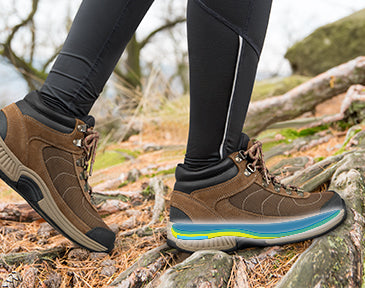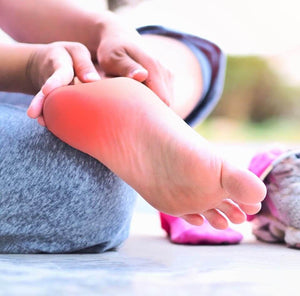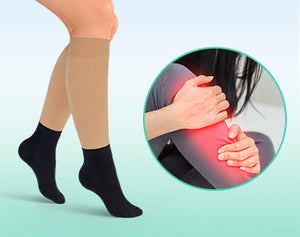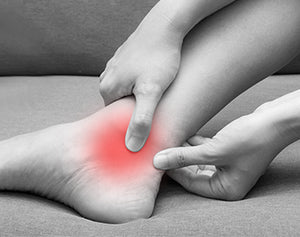The Orthofeet Blog
- All Posts
- All
- Arch Support
- Arthritis
- Back Pain
- Bunions
- Diabetes
- Flat Feet
- Foot Pain
- Golf Shoes
- Hammer Toes
- Heel Pain
- Heel Pain/ Heel Spurs
- Knee & Hip Pain
- Knee pain
- Morton Neuroma
- Neuropathy
- Orthopedic shoes
- Other
- Overpronation
- Plantar Fasciitis
- Swollen Feet
Plantar Fasciitis


Josh White DPM / August 12, 2021
Hiking with Plantar Fasciitis: What You Need to Know
Hiking with Plantar Fasciitis: What You Need to Know
Read Post-
Foot Care for Elderly: How to Care for Aging Feet
Medical information provided by Orthofeet Team / July 29, 2025Developing a consistent daily routine for foot care at home is one of the most important steps you can take to maintain healthy feet. These simple habits can prevent many problems and help you identify issues early. Daily Care Tips Wash your feet thoroughly every day with warm (not hot) water and mild soap [4]. Pay special attention to cleaning between your toes, where moisture and bacteria can accumulate. After washing, dry your feet completely, especially between the toes, as moisture in these areas can lead to fungal infections. Apply moisturizer to keep skin soft and prevent cracking, but avoid putting lotion between your toes where excess moisture can cause problems [4]. Use a quality foot cream or lotion specifically designed for dry skin, and pay particular attention to your heels where cracking is most common. Inspect your feet daily for any changes, including cuts, bruises, swelling, redness, or changes in skin color [4]. Use a mirror if necessary to see the bottoms of your feet, or ask a family member to help if you have difficulty seeing all areas clearly. Look for any signs of infection, such as increased warmth, persistent redness, or discharge from cuts or sores. Early detection of problems allows for prompt treatment and prevents complications. Healthy Habits Elevate your feet regularly to reduce swelling and improve circulation. When sitting, prop your feet up on a footstool or ottoman so they're level with or slightly above your heart. Even 15-20 minutes of elevation several times throughout the day can help reduce fluid buildup. Perform gentle stretching and exercises to improve circulation and maintain flexibility [4]. Simple ankle rotations, calf raises, and toe wiggling can help keep blood flowing and joints moving, offering seniors a good way to promote foot health. These exercises are particularly important if you spend long periods sitting or lying down. Wear clean, moisture-wicking socks that keep your feet dry and comfortable [4]. Change socks daily, or more often if your feet tend to sweat. Choose socks made from materials that pull moisture away from your skin, and avoid socks with tight elastic bands that can restrict circulation. Keep your toenails trimmed straight across to prevent ingrown nails [4]. If you have difficulty reaching your feet or have vision problems, consider having a podiatrist or other healthcare provider trim your nails safely. When to Call a Doctor Consulting a specialized doctor can offer the best solutions for persistent issues. Certain signs and symptoms require prompt medical attention [4]. Any sign of infection, including persistent redness, warmth, swelling, or discharge from a wound, should be evaluated by a healthcare provider immediately. Persistent or worsening pain that interferes with walking or daily activities needs professional evaluation. Don't assume that foot pain is a normal part of aging that you must tolerate. Numbness, tingling, or burning sensations that don't improve may indicate nerve problems that require medical treatment. These symptoms are particularly concerning for people with diabetes or other conditions that affect circulation. Sudden or severe swelling, especially if it affects only one foot or is accompanied by pain, could indicate a serious condition requiring immediate care. Any wound that doesn't heal within a few days or shows signs of getting worse should be examined by a healthcare provider, especially if you have diabetes or circulation problems. Choosing the Right Footwear for Aging Feet Proper orthopedic shoes become increasingly important as your feet change with age. The right shoes can prevent many problems and provide the support and comfort your aging feet need. Must-Have Features Wide toe boxes give your toes adequate space and prevent pressure on bunions, hammertoes, or swollen areas. Shoes that squeeze your toes together can worsen existing deformities and create new problems over time. Adjustable closures such as Velcro straps, elastic laces, or multiple strap systems allow you to modify the fit as your feet change throughout the day [4]. This adjustability is particularly important if you experience swelling or have arthritis that makes traditional laces difficult to manage. Slip-resistant soles provide stability and reduce fall risk. Look for shoes with textured rubber soles that provide good traction on various surfaces, both wet and dry. Lightweight cushioning helps absorb impact and reduces stress on your joints. Quality cushioning in the heel and forefoot areas compensates for the natural loss of fat padding that occurs with age. Orthotic support helps maintain proper foot alignment and reduces strain on muscles and joints. Built-in arch support is particularly important if your feet have flattened over time or if you have conditions like plantar fasciitis. The Fit Factor Measure your feet regularly because aging feet often change in size and shape [2]. What fit perfectly a year ago may no longer be appropriate. Have your feet measured at least once a year, or whenever you notice your shoes feeling different. Shop for shoes in the afternoon or evening when your feet are slightly swollen to their largest size of the day. This ensures that shoes will be comfortable even when natural swelling occurs. Ensure shoes are snug but not tight. You should have about a thumb's width of space between your longest toe and the front of the shoe. The shoe should hold your foot securely without creating pressure points or allowing excessive movement. Look for adjustable features that accommodate daily changes in foot size due to swelling or stiffness. Shoes that can be loosened or tightened as needed provide better comfort throughout the day. Orthofeet Footwear Options for Elderly Foot Care At Orthofeet, we understand that how to care for aging feet includes choosing footwear designed specifically for the challenges that come with age. Our orthopedic shoes address the common problems that affect older adults while providing the comfort and support needed for daily activities. Our shoes feature premium orthotic insoles that provide targeted arch support and help maintain proper foot alignment. This support is crucial for people whose feet have changed shape over time or who have conditions like arthritis that affect foot function. Extra depth and wide-width options accommodate foot deformities, swelling, or the need for custom orthotics. Our designs ensure that people with bunions, hammertoes, or other age-related foot changes can find comfortable, supportive footwear. Cushioned, shock-absorbing soles help compensate for the natural loss of fat padding in aging feet. This cushioning reduces impact on joints and makes walking more comfortable on hard surfaces. Breathable, stretchable uppers adjust to your foot's shape and accommodate minor swelling that may occur throughout the day. These materials help prevent pressure points while providing a secure, comfortable fit. Easy-to-use closures make our shoes accessible for people with arthritis or limited mobility. Many of our styles feature Velcro straps, elastic laces, or other adjustable systems that don't require fine motor skills to operate. Our specialized collections include shoes for foot pain, shoes for swollen feet and edema, and orthopedic shoes for women and men’s orthopedic shoes. Taking proper care of your aging feet is an investment in your independence and quality of life. By understanding the changes that occur with age, developing consistent daily care habits, and choosing appropriate footwear, you can keep your feet healthy and comfortable for years to come. Remember that foot care for elderly individuals isn't just about treating problems after they develop. It's about preventing issues before they start and maintaining the mobility that allows you to continue enjoying the activities you love.[product-group-tile]================================Sources: [1] PubMed. "Foot care for the aging." 1987. https://pubmed.ncbi.nlm.nih.gov/3194453/ [2] PMC. "Foot Examination for Older Adults." 2021. https://pmc.ncbi.nlm.nih.gov/articles/PMC9614715/ [3] PubMed. "Foot disorders in the elderly: A mini-review." 2017. https://pubmed.ncbi.nlm.nih.gov/28826743/ [4] Emory Healthcare. "Foot Care for Seniors: 10 Important Tips." https://www.emoryhealthcare.org/stories/wellness/foot-care-for-seniors-10-important-tipsRead More -
Do Bunion Socks Really Work? Get the Truth About Their Effectiveness
Medical information provided by Orthofeet Team / July 28, 2025If you’ve got a painful bump forming at the base of your big toe, you’re probably dealing with a bunion. This happens when the joint shifts out of place, pushing the big toe inward and creating that familiar bulge on the side of the foot. Since this joint carries a lot of your weight when you walk, bunions can get pretty uncomfortable and over time, even wearing regular shoes might start to hurt [1]. Naturally, people look for treatments to ease that pain without jumping straight to surgical solutions, which is a solution used in severe cases. That’s where bunion socks come in. But do bunion socks really work, or are they just another gimmick? And more importantly, do bunion relief socks really work when it comes to daily comfort? Let’s take a look at socks, bunions and everything in between. What are bunion socks and how do they work? The answer to the question ‘do bunion socks really work?’ has to start with getting to know these comfortable socks. Here’s what you need to know. The design and purpose of bunion socks If you’ve never seen bunion socks before, think of them as a hybrid between a regular sock and a soft toe-straightening gadget. They’re usually made from a stretchy, breathable fabric, so they feel like normal socks, but they come with a few clever features to help people dealing with bunions. Most bunion socks have either built-in toe separators or reinforced zones around the bunion area. These features are designed to gently guide the big toe back into a more natural position and ease pressure on the joint. The idea is to support the alignment of the foot without any rigid devices or complicated straps. The toe separator also helps prevent toe overlapping and friction, which puts extra pressure on the bunion. You just pull them on like regular socks, and they do their job while you go about your day. So, in a nutshell: bunion socks aim to reduce discomfort by providing light alignment support and easing stress on the big toe joint. If you're wondering, do bunion socks really work when you use them this way? The answer depends on how early you're catching the issue, such as bunion deformity, and the type of relief you’re expecting. The impact of tight shoes on bunions Wearing tight shoes is often a major cause of bunion formation and can escalate the discomfort further. They force the toes into unnatural positions, increasing pressure on the bunion area and aggravating the pain and swelling. Selecting footwear that provides ample room in the toe box and accommodates bunion deformity is crucial in preventing the progression of symptoms. Comfortable, well-fitting shoes can reduce the pressure on your toes and decrease pain associated with bunions. Orthopedic footwear is also recommended as it is specifically designed to address these issues, enhancing overall foot health and reducing the need for surgical interventions. How bunion socks help with pain relief Bunion socks are made to apply gentle compression, which can help improve circulation and reduce inflammation around the bunion area, similar to what compression socks do. This compression may ease soreness, especially after a long day on your feet. Another helpful feature is the soft toe separation. It doesn’t yank your toe into place like rigid bunion splints would, but it gently creates a little space between your big toe and its neighbor. This can relieve pressure on the joint and help reduce that constant ache many bunion-sufferers know all too well [2]. Many of the socks are also designed with a bunion pad to add another level of protection. That said, do bunion relief socks really work for everyone? Not necessarily. Bunion products, like bunion socks, are generally most useful for people with mild to moderate bunions or just starting to feel discomfort. They won’t permanently correct your toe or reverse the bunion itself [2], but they can make things a lot more comfortable while you’re wearing them. Think of them as a low-key, wearable way to manage the symptoms without committing to anything drastic. Do bunion socks provide long-term relief? If you’re hoping that bunion socks will magically straighten out your big toe and erase that bony bump for good – sorry, that’s not how they work. While bunion socks can definitely help ease some of the discomfort that comes with bunions, they’re not designed to fix the root of the problem. What they do provide is temporary relief. Some people report feeling less pain, especially if their socks have built-in toe separators or light compression. That extra space between the toes can help reduce friction, and the gentle pressure might ease some of the soreness or swelling. You might even notice fewer corns or hot spots from your shoes. But the truth is, bunion socks won’t reverse or correct a bunion once it’s already formed. So, do bunion socks really work for long-term relief? Not as a standalone fix, but they do have value as part of a broader foot care routine. And do bunion relief socks really work well enough to be worth a try? If you're dealing with early-stage discomfort and want something low-maintenance, yes – they're definitely worth a shot. Think of them as one piece of a bigger puzzle. They are just one of the many products aimed at providing relief and improving foot health. They’re most effective when used along with other treatments, like wearing bunion shoes with a roomier fit, orthotics to reduce joint stress, or stretching and strengthening the feet. And for people who aren’t ready for surgery or don’t need it yet, bunion socks can be a nice addition to a daily pain management routine. Alternatives to bunion socks for bunion pain relief Bunion socks can be a comfy option for easing discomfort, but as we stressed earlier, they’re far from the only way to manage or treat bunion pain. If you're looking for something more supportive, or just want to switch things up, there are other tools that can help take pressure off your feet and improve how they feel day to day – from bunion correctors to bunion exercises. But two of the most popular options that your doctor may recommend as part of your treatment plan are orthotic insoles and orthopedic footwear. Orthotic insoles for bunion relief If your feet are constantly working overtime to keep you balanced, the right insoles can make a big difference. Orthotic insoles are designed to support the natural shape of your foot and spread pressure more evenly, so there’s less stress on the bunion area. That means less pain and more comfort when you're on the go. Good insoles usually include key features like quality arch support to keep the foot aligned, cushioned heels to absorb impact, and sometimes even a built-in metatarsal pad to ease pressure at the front of the foot. All of this helps improve alignment, especially if you tend to overpronate (when your feet roll inward too much). Orthofeet’s orthotic insoles are a good example – they’re built with bunion relief in mind and designed to reduce excess motion, stabilize your foot, and keep pressure away from sensitive areas. They’re helpful even if you’re not quite ready for custom orthotics but still want noticeable support, although they have enough depth and come with removable orthotic insoles so you can easily replace them with your own. Bunion orthopedic footwear Shoes can either make your bunions worse or help you forget they’re even there. The best orthopedic shoes designed for bunion relief focus on creating space and reducing pressure in all the right spots. Here’s what to look for: A roomy toe boxGives your big toe enough space to move without rubbing against the side of the shoe. Soft, stretchable materialsAdapt to the unique shape and form of your foot to prevent irritation over the bunion. Extra depthAvoids squeezing the toes and makes it easier to accommodate orthotics if needed. Wide or extra-wide widthsOffer more breathing room for swollen or sensitive areas. Supportive solesHelp keep your foot in a more natural, aligned position, which can reduce pressure on the bunion, and absorb impact on the foot as you walk or run. The arch support in orthopedic footwear works wonders by reducing additional stress on the foot. Orthofeet’s bunion shoes include all of the above, and then some. With ergonomic soles, pressure-free uppers, and built-in orthotic insoles, they’re designed to support your feet and ease bunion pain so you can move more comfortably throughout your day. More ways to support your feet If you have swelling or tired legs at night, you might want to read about whether you can sleep in compression socks and whether this helps with circulation. For anyone comparing sock types, check out the detailed guide on diabetic socks vs. compression socks to help you choose the best pair for your needs. And if you’re not sure whether your socks fit just right, this article on how tight compression socks should be can help you get the most relief. Bunion socks from Orthofeet When you’ve got bunions, even the smallest details, like the kind of socks you wear, can make a real difference. Orthofeet’s bunion socks are designed with exactly that in mind: small, thoughtful features that add up to a lot more comfort. They’re made with a split toe design that gently separates your big toe from the rest. It might seem like a tiny thing, but it helps with natural toe alignment and keeps your toes from overlapping – two big wins if you’re dealing with bunion pain. Add to that a seamless construction, which means no annoying friction points, mild compression for blood flow improvement, moisture-wicking materials to keep your feet dry, and non-constrictive, loose knit construction with extended stretchability that doesn’t feel tight on your feet, and you’ve got a sock that’s clearly built for comfort. They also come in a two different styles and types: High-cut (above the ankle) with or without padding Low-cut (below the ankle) for a more discreet fit They are also available in an unusually broad range of sizes for women and men, making it easier to find a pair that fits just right. These socks are a great option for anyone with early-stage bunions, mild toe alignment issues, or just looking for some post-walk recovery. They fit easily into regular shoes and feel good whether you’re out running errands or putting your feet up after a long day. Simple, practical, and quietly effective – just like a good sock should be.[product-group-tile] ================================= [1] Cleveland Clinic team. Can You Shrink Bunions Naturally? Cleveland Clinic. November 29, 2024. Accessed May 25, 2025. https://health.clevelandclinic.org/how-to-shrink-bunions-naturally [2] Daniel Yetman, medically reviewed by Debra Sullivan. Do Bunion Correctors Actually Work to Treat Bunions and Relieve Pain? Healthline. September 8, 2021. Accessed May 25, 2025. https://www.healthline.com/health/do-bunion-correctors-work#how-bunion-correctors-workRead More -
9 Effective Ways to Alleviate Foot Pain from Standing All Day
Medical information provided by Josh White DPM / November 01, 2024Learn 9 effective ways to alleviate foot pain caused by standing all day, featuring Orthofeet’s orthopedic shoes designed for maximum comfort and support.Read More -
How to Prevent Bunions From Getting Worse
Medical information provided by Steven Gershman DPM / October 25, 2022Bunions are very common, but that does not mean they are a trivial issue. When it comes to severe bunions, they can evolve into a debilitating condition and even require surgery. If you have bunions, there are quite a few things you can do to prevent them from deteriorating. What is a Bunion? The medical term for a bunion is "Hallux Abducto Valgus “, or just "Hallux Valgus”. Bunions are a deformity of the big toe area of the foot that looks like a bony bump on the inside or medial side of the foot, just behind the big toe on the first metatarsal head, and the big toe angulates toward the second toe. Sometimes, the big toe actually overlaps the second toe or goes under it. The bump is actually the first metatarsal head that has shifted out away from the foot and widened it. This bump can enlarge due to inflammation from shoe pressure rubbing on it. Bunions can cause pain due to inflammation and poor shoe fitting. They can also lead to balance issues because they change the way your foot moves. This demonstrates how wearing the wrong shoes can cause balance problems, adding to the discomfort and difficulties caused by bunions. How Do Bunions Occur? Generally, bunions are a result of biomechanical flaws in the foot that are genetic or congenital. It is common to see bunions go from generation to generation, most commonly in women. Women are more prone to bunions, because they tend to have more flexible joints and ligaments, including in the foot, due to the necessity to give birth. This results in increased motion that allows any biomechanical flaws to be exacerbated, causing shifting of the bones and then bunions. Shoes can also be an issue. In addition, arthritis and other joint and connective tissue disorders can add to bunion formation. Do Bunions Get Progressively Worse? In most cases, bunions get worse gradually only if you don’t wear the right shoes and don’t get any treatment. Adequate shoes are critical to alleviating bunion pain and discomfort, and making sure they don’t become worse. While shoes alone don't cause bunion development, they can amplify the underlying biomechanical flaws. Shoe types such as dress shoes, high heels, pointed toe box and slip on shoes are all culprits. 4 Tips On How To Prevent Bunions From Getting Worse First, I want to point out one thing: bunions cannot be prevented if they are a result of a foot structure you were born with. However, the speed of formation and severity of deformity can be affected and slowed. All other causes of bunion development can be prevented with proper support and shoes. The underlying biomechanical issues we are born with are potent and cannot be changed easily. Once we put shoes on at a young age, we fundamentally change the shape and biomechanics of the foot forever. It’s like orthodontia for the teeth. Shoes immediately put pressure on the forefoot forcing the toes together and pushing the big toe inward, changing the anatomy, including the shape of the bones and the location of the cartilage. Looking at pictures of feet in some societies that never wear shoes, you can clearly see feet that look dramatically different than the feet that wear shoes. Without shoes, the toes are separated in a way that looks like a hand. Seeing as bunions can develop into a debilitating condition that might even require surgery, here are some tips on how to treat your bunions correctly, before they become too severe. 1. Don’t wear the wrong shoes Shoes can and do affect the severity of the anatomical changes that occur in bunion formation, and the associated symptomology. Basically, the more the shoe forces the big toe toward the second toe and allows excess motion, the worse the deformity. That’s why narrow pointed toe box shoes are a major factor. Unfortunately, many women's shoes are shaped that way for style. High heels are particularly damaging as they force the foot into an altered biomechanical position and jam the forefoot and big toe into the floor, shifting the big toe’s position. : 2. Orthotics are important As noted above, excess motion in the foot is one major cause of bunions and one cause of excess motion is over pronation. This issue, where the foot rolls inward excessively, is closely linked to flat feet. Understanding the causes of flat-foot overpronation is key to addressing both the symptom and its root cause effectively. Pronation is a natural motion the foot goes through as we walk and stand that loosens the foot. Pronation rolls the foot inward and drops the arch. This allows shock absorption and adaptation to changes in the terrain, so the foot can deal with uneven surfaces. In over pronation, the arch drops downward or inward excessively, found in many common foot problems. We can treat over pronation and the resulting excess motion it causes with orthotics in the shoes. Orthofeet designs well-made over the counter orthotics that are designed to support the arch, control over pronation, align the foot and correct the gait. I use a lot of these in practice and they have helped my patients tremendously. In more severe cases, a true rigid custom orthotic is required. Although there is no definitive proof of this, it is believed by many podiatrists that orthotics started early can significantly alter the severity of bunions and slow down the progression. 3. Know which shoes to look for In addition to orthotics, shoes are the other significant factor in bunion formation and severity. As noted above, shoes that have a narrow or pointed toe box are a major factor in speeding up and increasing severity of bunion formation. The best bunion shoes should be designed with the following features: Shoes for bunions need to have a wide, round and high toe box. The less pressure on the big toe, the better. Orthofeet shoes have a very round deep toe box with lots of room. I wear them myself, due to the comfort factor and since members of my family had severe bunions and I have the excess pronation and motion that could form bunions. If you already have bunions, the best shoes for bunions should have a round toe box and extra depth for the big toe, often being over or under the second toe. Also, extra depth shoes are critical, because they add stability and reduce motion, and can easily accommodate orthotics. Wide or extra wide shoes also are critical for bunions. Most shoes found today in big box stores only carry one width, usually medium, which is far from what a bunioned foot needs. The good news is that specialty footwear brands design shoes in extended widths - from narrow all the way up to extra extra wide! In many cases, bunion pain relief is as easy as wider shoes with a round toe box. The material of the shoes is very important for feet with bunions. Shoes constructed with tight and unforgiving materials will apply pressure on the bunion, worsen the condition and cause pain. However, comfortable shoes made with stretch knit uppers offer a relaxed fit and conform to the contours of your foot, specifically the bunion, to create a pressure free environment. Supple leathers can also work well. I have many patients with very wide feet from bunions who wear these after failing in most other shoes. Whatever material they are made of, it is important the upper is free of overlays or stitching across the sensitive bunion area. The interior of the shoe should be soft and padded to offer the utmost protection, preventing any further injury or friction to the painful area. Ideally, a seam free construction is best. Shoes for bunions should have a low heel or be flat to the ground to avoid forcing the forefoot into the floor, as is the case with heels. It’s also best to look for shoes that have an ergonomic sole with a mild rocker bottom that facilitates foot motion and transfers weight evenly from the rearfoot to the forefoot. 4. Other Bunion Relief Options Pain relief is key if you have a bunion and there are other options that are available for those who have minor cases of the condition. Bunions Socks. Bunion socks are not a means to prevent the deformity, but they can provide added benefits, such as separating the big toe from the remaining toes. This ensures the toes do not overlap and rub against each other, causing irritation. Orthofeet also offers bunion socks and they are super comfortable, as they’re made with soft bamboo fibers, offer a non-binding fit and wick moisture away from the foot. Bunion Pads. If you are looking to protect the bunion from anything that touches and rubs against it, bunion pads can help. Note that some pads are medicated with acid in them that can burn the skin. Do not use these! Simple protective pads will do the job just fine. How to Stretch Shoes for Bunions Although not my first choice and not as effective in treating and preventing bunions, there are some who like to make shoes wider for bunions by stretching them. The one useful device I have in the office to accommodate for the large bump of the bunion on the side of the foot is the Ball and Ring Stretcher. This device pushes out the toe box in one spot only, directly over the bony bump. Most podiatrists have this device and will be able to stretch your shoes if you bring them in. But, while stretching your shoes is helpful I want to reiterate that the best solution for people with bunions is to buy special shoes for bunions, like shoes for men with bunions and women’s bunion shoes, which come with all the design features I mentioned earlier: a wide toe box, soft stretchable uppers and special orthotic shoe inserts that provide arch support, reduce over pronation and help straighten the toes. See your podiatrist for more information and help with bunions. In the worst cases, surgery can correct bunions permanently. Surgery is the only true bunion treatment as it gets to the root of the problem.Read More -
How to Make Shoes Wider for Bunions
Medical information provided by Josh White DPM / September 22, 2022If you have bunions, you already know that too-tight shoes are an open invitation to lots of pain and discomfort. And to make matters worse, they will exacerbate the condition. If you own a pair of shoes that are too narrow for your feet and you suffer from bunions, you have two options: Stretch them so that they fit you more comfortably. Purchase shoes that are specifically designed for feet with bunions. How to Stretch Shoes for Bunions Take it to a shoemaker Naturally, shoemakers or shoe repair shops are skilled in stretching shoes, using professional tools and machines. Unfortunately, these shops are becoming more and more rare, but if you can find one in your area it can be a good solution. Use a professional shoe stretching tool Shoe stretchers usually come with a liquid or spray that you apply on your shoe before you insert the stretcher into it. Stretching liquids and sprays are available for a variety of shoe materials - fabric, leather and vinyl - and they loosen up the material, making the stretching process more effective. Once you insert the stretcher, you need to twist its widening handle to expand the shoe. Then, leave the shoe stretcher inside the shoe for 24 hours, until your shoes are wide enough. Apply heat This simple method is best used on shoes made from leather or suede, because other materials could be ruined by the heat. Before heating your shoes, put on a thick pair of socks and slip your feet into your shoes. Then, take a hair dryer, turn it on high and point the hot air toward the tight areas of your shoe. Continue blowing the hot air, while simultaneously stretching the shoe by wiggling and flexing your feet and toes. Once you’ve shut off the dryer, continue wearing your shoes with the thick socks for a little longer. Spray rubbing alcohol. First, mix 50% water with 50% rubbing alcohol and spray or rub it on your shoes. Next, wear the shoes immediately after treating them with the alcohol, repeating the process if necessary. However, don’t overuse the spray as it could damage the shoe fabric. This method works best on natural fabrics. Stuff your shoes with potatoes or wet newspapers. Take a potato large enough to stretch out your shoe, or wet newspapers that have expanded to a size large enough to stretch out your shoe, and insert them into your shoes. After two days, your shoes should be stretched out enough. Whether you choose to stretch out your existing pair of shoes or shop for bunion relief shoes, pair them with our bunion socks for added comfort and relief. Insert a bag of ice Fill freezable plastic bags with water, put them inside your shoes. Make sure the bags are completely sealed! Then, put the shoes in the freezer overnight. As the water freezes, it will expand and stretch out your shoe. When you remove the shoes and take out the bag in the morning, let your shoes dry before trying them on. Shop Now for Bunions Shoes Do tight shoes make bunions worse? The short answer is: yes! The more detailed answer is that bunions are usually caused by genetic or congenital biomechanical defects in the foot. Bunions are more common in women, because their joints and ligaments are more flexible, resulting in increased motion. This excess motion exacerbates the faulty foot structure, causing bones to shift and resulting in bunions. Bunions can also develop due to other foot conditions, such as flat feet and abnormal bone structure. If the problematic area of the bunions is jammed in the shoe, as is the case with shoes that are too tight, the forefoot is pushed forward into the toe box. This crowds the toes, applies pressure on the big toe, exacerbates the defective foot structure and worsens the symptoms of bunions. “Although preventing bunions is not possible, shoes can and do affect the severity of the anatomical changes that occur in bunion formation and the associated symptomology,” explains Dr. Steven Gershman, a podiatrist. “Basically, the more the shoe forces the big toe toward the second toe and allows excess motion, the worse the deformity”. Still, tight shoes are not the only culprit and there are other causes that can make things worse for your bunions: High heel shoes and narrow pointed shoes that also crowd the toes. Spending long hours on your feet. Foot conditions such as arthritis, overpronation, flat feet and more. Can shoes be stretched to accommodate bunions? Bunions create a bump on the interior side of the foot, just under the big toe, angulating the big toe toward the second toe. Naturally, this bump adds width to the foot and can become larger due to pressure applied by the shoe. So basically, bunions don’t only cause pain and even balance issues, but can also make it hard to find shoes that fit properly. Stretching shoes to accommodate bunions can help and you can even find good stretchers that push the toe box in one specific spot, directly over the bump of the bunion. But, although stretching can help, the width of the shoe is not the only factor to take into account when looking for shoes that are best for bunions. Why it's better to buy shoes for bunions rather than stretch them? We’ve already established that increased motion in the foot is a major cause of bunions, while various foot conditions, such as overpronation, can make matters worse. So, buying shoes that help address these issues can also help your bunions. More specifically, good quality orthotics that support the arch, align the foot, help straighten the toes and correct the gait, can treat overpronation and the increased motion it causes, and therefore alleviate bunion symptoms, pain and discomfort. Moreover, using orthotics in the early stages of bunions is believed by many podiatrists to significantly slow down the progression of the bunions. But orthotics are not the only design feature that can treat and even prevent bunions. Look for the following design features and shoes: Wide enough front to accommodate your toes and bunions comfortably. The best toe box for bunions is wide, high and round, with extra depth for the big toe. Extra depth shoes also allow you to insert custom orthotics if you need to, and help reduce excess motion. Wide width shoes that, together with the deep toe box, can make all the difference to your bunions, provide relief and prevent the bunions from getting worse. Shoes made from a stretchy material that eliminates pressure on the bunions. The best pressure-free material would be one that can not only stretch, but also conform to the contour of your foot and bunion. Shoes with straps or laces that allow you to adjust the fit if you need to, because the size of your bunion can change over time and even during the day. Low heels or flat shoes that don’t push your feet into the ground, applying pressure on your toes. Ergonomic sole, preferably with a mild rocker bottom that decreases joint movement and disperses the pressure evenly across the foot. Finally, here’s a tip on how to lace shoes for bunions. Use the bunion step-over technique. With this technique, you simply bypass the eyelet that overlays your big toe joint. This lacing method significantly minimizes the pressure on the bunion.Read More









